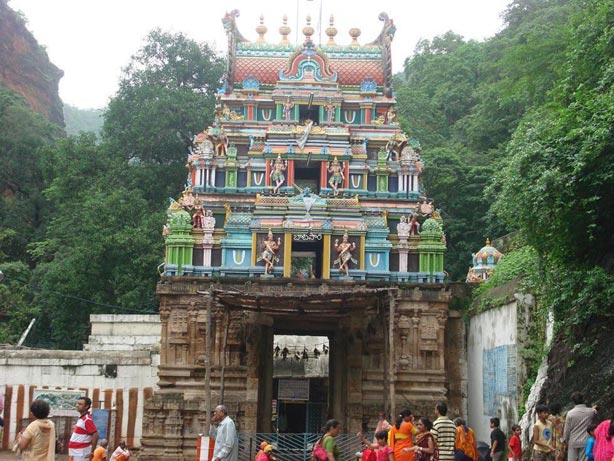
Ahobilam also known as Ahobalam is located in the Allagadda mandal of Kurnool district in Andhra Pradesh, India. It is located at a distance of 70 km from Nandyal and about 150 km from Kurnool, the district headquarters. There are two temple houses, lower Ahobilam and upper Ahobilam.
According to the legend, this is where Lord Narasimha blessed Prahlada and killed the demon Hiranyakashipu.
There are nine temples around the Nallamala Forest range, and in terms of sculpture and architecture all these nine temples stands to be an ultimate testament for the ancient sthapathis in planning and sculpting these temples. A few temples can be reached through trekking. Some temples are inside the cave. Some temples are very difficult to trek to.
The nine planets that define the human fates are believed to have worshipped these nine Lord Narasimhas to get relief from Rakshashas (demons) and curses of sages for their actions. This is main theme of the work of the great Telugu poet Errana, the “Nrisimha Puranam”. The hereditary powers of the temple rest with the Pontiff HH Azhagiyasingar of Ahobila Mutt.
Currently the 46th Jeeyar of this lineage is the reigning Pontiff. Occasionally when HH Jeeyar performs Mangalasasanam (pays respects at the temple) at Ahobilam, the Serthi Utsavam is performed (the Moolavar of Malola Nrusimhar and the Utsavar) are united. The Nallamala hills are personified as Adisesha with his head at Tirumala, middle at Ahobilam and the tail at Srisailam.
Legend
According to legends it is believed that when the Devas saw the manifestation of Lord Vishnu as half-lion, half-man, they shouted “Ahobala” (great strength) as well as “Ahobila” (great cave in which the current sanctum is). Hence, this place could be called either “Ahobalam” or “Ahobilam”. The mention of this place is present in Brahmanda Purana. The place where Lord Narayana appeared from the stone pillar to kill Hiranyakashipa can be seen in this place. The name of this pillar is Ugra Sthambha, which is now referred as “Ukku SThambha” in Telugu, which incorrectly translates to iron pillar.
Diguva and Eguva (Lower and Upper Ahobilas)
In the lower Ahobila Lakshmi Narasimha Swami is in a peaceful form. The temple has exquisite stone art. The history of Ahobila temple is sculptured in the stone form. Lord Srinivasa himself is said to installed the main deity here. He is said to have sought the blessings of Narasimha before his wedding but finding the Narasihma in fierce form in Upper Ahobila, he is said to have installed the peaceful form in the lower Ahobila. The temple complex also had temples for Adivan Sathagopulu. The sculptures of coronation of Lord Srirama (Sreerama Pattabhishekha), the ten incarnation of Lord Vishnu (Dasavatharas), statues of Poet Annamacharya are present on the walls of the temple. Annamacharya is said to have spent some time here composing songs praising the Lord Narasimha. The great sage Lord Pothuluri Veerabrahmendra Swamy is said to have meditated here to write Kalagnana (the knowledge of the future) which set forth a spiruitual movement. It is a common practice to worship the Prahlada Varada Narasimha (the Narasimha who gave boons to Prahlada) in lower Ahobilam before worshipping Eguva (Upper) Ahobila Narasimha, who is present eight kilometers away on a hilltop inside a cave. After worshipping the Lord, it is another practice to visit Navanarasimhas (nine Narasimhas). The legend says Lord Narasimha, after slaying Hiranyakasipa was roaming around the forest hills of Ahobilam making fearsome laughs and settling at nine places to bless the devotees. Here are the Nava Narasimha temples. Another legend describes when Lord Garuda did penance to see Lord Vishnu in Lord Narasimha form. Thereafter, LordNarasimha took nine different forms in this hill.